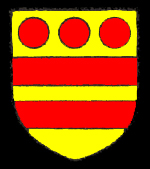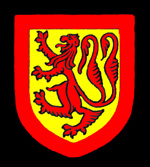The Manor of Shelton

The Wake family coat of arms
The histories of manors in Bedfordshire are given in Volume III of The Victoria County History for Bedfordshire published in 1912. At the time of the Domesday Book of 1086 the manor of Shelton was held by the Bishop of Coutances. By the 13th century the overlord was Patrick de Chaworth by before the end of the century it was in the hands of the Wake family. The overlordship is last mentioned in 1443.
The earliest known tenant of the manor is Henry de Soleby who held it from the overlord. In 1291 Joan Soleby succeeded her father William. She probably married Sir Richard de Musgrave who held the manor in 1316, granting it in that year to William le Englys for his life at a rent of 25 marks per annum. Richard was succeeded by Robert de Musgrave who settled the manor on his wife Elizabeth. She seems to have conveyed it because in 1346 it was held by John FitzWilliam. By 1387 the Lord of the Manor was Sir William Marmyon who quitclaimed the manor (the first time it was so called in surviving documents) to John la Warre, Anketin Malory, William Palmer and others in that year. In 1398 la Warre, Palmer and others quitclaimed the manor to Sir Gerard Braybrook the younger, Sir William Malory of Papworth [Cambridgeshire] and others for 200 marks.

The Malory family coat of arms
Sir William Malory died as Lord of the Manor of Shelton in 1445 and was succeeded by his son Thomas. The Malorys continued to hold the manor until 1667 when Peter Malory conveyed it to William Busby for £300. It seems as if the Malorys may have then bought it back because in 1714 Francis Malory sold it to Theophilus Dillingham for £520.
The Dillingham family still held the manor in 1794 but by 1813 the owner was Henry Harris. Harris was succeeded by his son Thomas in 1842 and he by his daughter Mrs. Whitehead in 1880. She was still the owner in 1912. A succession of Law of Property Acts in the 1920s extinguished all manorial incidents, courts and copyhold tenure of land. This effectively abolished manors in all but name.
Manor houses usually stood within a moat. Shelton Hall stands within the remains of just such a moat. This, the fact that it stands near the church, as manor houses often did and the fact that it seems to contain medieval masonry all strongly suggest that the hall stands on the site of the medieval manor house and may, indeed, incorporate some of that building in its present structure.
![Shelton Hall in 1979 [Z50/102/1]](/CommunityHistories/Shelton/SheltonImages/Shelton Hall in 1979 [Z50-102-1].jpg) Shelton Hall in 1979 [Z50/102/1]
Shelton Hall in 1979 [Z50/102/1]